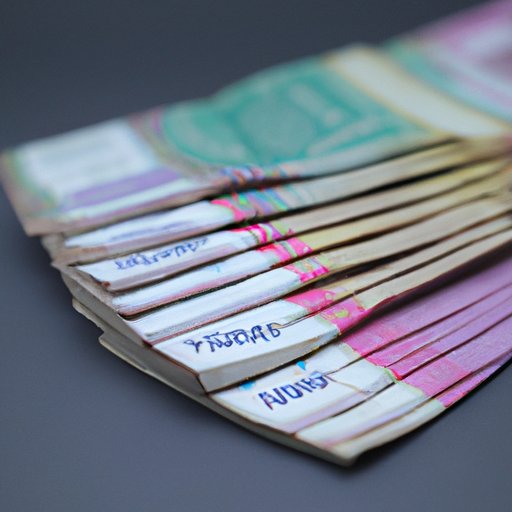
Introduction
Have you ever wondered about the history and significance of paper money in today’s global economy? Currency is a fundamental aspect of society, serving as a medium of exchange for goods and services. Throughout history, societies have used different forms of currency, from bartering to coins and paper money. This article explores the invention and evolution of paper money, its cultural and economic implications, and its relevance in the digital era.
Historical Overview of the Invention of Paper Money
The origins of paper money date back to ancient China during the Tang Dynasty (618-907 AD). At this time, Chinese merchants used promissory notes to carry out transactions. These notes served as IOUs or debt certificates, with the promise of payment at a future date. Paper money eventually replaced these promissory notes, with the first recorded use of paper currency occurring during the Song Dynasty (960-1279 AD).
Throughout history, societies have used different forms of currency. In ancient times, metallic currency, such as coins made of silver or gold, was commonly used. In contrast, paper currency emerged during the late Middle Ages in Europe in the form of banknotes. However, paper money only became widely used during the 19th century with the establishment of central banks.
Comparative Analysis between Paper Currency and Other Forms of Currency
Compared to metallic currency, paper money is more portable and easier to use since it is lighter and more flexible. On the other hand, metallic coins have intrinsic value due to the precious metals used. While paper currency has no intrinsic value, it is backed by the government or central bank, ensuring that it retains its worth.
Compared to digital currencies, paper money does not require a technological infrastructure such as an Internet connection or a digital wallet. It also ensures anonymity and does not leave a paper trail, making it attractive to some users. However, paper currency is more vulnerable to theft or counterfeiting, and it can be difficult to track monetary flows.
The Cultural, Economic, and Political Factors That Led to the Emergence of Paper Currency
Many factors led to the emergence of paper money, including political and economic changes. One of the main reasons for its invention was to fund the growth of armies and to finance wars. Governments needed a reliable way to raise money without devaluing their currency, which is where paper money came in. Additionally, paper currency helped to facilitate long-distance trade and reduce the need for bulky metallic currency.
As paper money spread throughout different cultures, each society added its own unique elements. For instance, Chinese banknotes featured intricate designs, including calligraphy and artwork, which reflected the culture of the time. Similarly, European banknotes featured the portraits of famous individuals or allegorical representations of values, such as freedom or progress.
From an economic perspective, the widespread use of paper money has helped to reduce the transaction costs associated with conducting trade. By eliminating the need for physical currency, paper money has streamlined the exchange of goods and services. However, its introduction has also sparked inflation, currency devaluation, and other economic issues.
Impact and Evolution of Paper Money in the Modern Era
Today, paper money continues to play a crucial role in global finance and trade. As the global economy becomes more interconnected, paper money helps facilitate the exchange of goods and services between different countries. Technology has also revolutionized the way we use paper money, with innovations such as digital wallets and contactless payments making transactions faster and more convenient.
However, paper money also faces challenges in the modern era. With the rise of digital currencies, such as Bitcoin, some argue that paper money may become obsolete. Moreover, technology has made it easier for counterfeiting to occur, and governments must take measures to ensure the integrity of paper money.
Analysis on How Paper Money Has Changed Over Time and Its Relevance in the Digital Age
Over time, paper money has evolved to address the needs of society. From its origins as a promissory note in China, it has become a global currency used for everyday transactions. Today, paper money faces stiff competition from digital currencies, which offer faster transaction times and greater anonymity. As such, central banks must adapt to the changing landscape to remain relevant in the digital age.
The Economics of Paper Money All Over the World, Pros and Cons
The use of paper currency has both positive and negative impacts on society. On the one hand, paper money makes transactions easier and more convenient. It also helps to spur economic growth and encourage entrepreneurship. However, it also has negative impacts, such as inflation or devaluation, which can hurt consumers and businesses alike. Governments must balance the pros and cons of paper money to ensure that it benefits society as a whole.
Top Inventions That Changed the World: Paper Currency
When considering the most significant inventions in history, paper currency undoubtedly takes a place near the top of the list. It has revolutionized the way we conduct transactions, facilitating trade across borders and cultures. It has played a crucial role in economic and political developments, making it a truly transformative invention that has changed the course of history.
Conclusion
Paper money has come a long way since its origins in ancient China, becoming a global currency that facilitates transactions in everyday life. Its cultural, economic, and political implications are far-reaching, helping to create and sustain the global economy. While digital currencies may present challenges, paper money remains a significant invention that has changed the world in countless ways.
Further reading: “The Power of Money” by Jacques Attali, “Money: Master the Game” by Tony Robbins, “Debt: The First 5,000 Years” by David Graeber.





